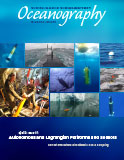Boning, C.W., A. Dispert, M. Visbeck, S. Rintoul, and F.U. Schwarzkopf. 2008. The response of the Antarctic Circumpolar Current to recent climate change. Nature Geoscience 1:864–869, https://doi.org/10.1038/ngeo362.
Bourassa, M.A., S.T. Gille, C. Bitz, D. Carlson, I. Cerovecki, C.A. Clayson, M.F. Cronin, W.M. Drennan, C.W. Fairall, R.N. Hoffman, and others. 2013. High-latitude ocean and sea ice surface fluxes: Challenges for climate research. Bulletin of the American Meteorological Society 94:403–423, https://doi.org/10.1175/BAMS-D-11-00244.1.
Farrar, J.T., L. Rainville, A.J. Plueddemann, W.S. Kessler, C. Lee, B.A. Hodges, R.W. Schmitt, J.B. Edson, S.C. Riser, C.C. Eriksen, and D.M. Fratantoni. 2015. Salinity and temperature balances at the SPURS central mooring during fall and winter. Oceanography 28(1):56–65, https://doi.org/10.5670/oceanog.2015.06.
Fitzpatrick, P.J., Y. Lee, R. Moorhead, A. Skarke, D. Merritt, K. Kreider, C. Brown, R. Carlon, G. Hine. T. Lampoudi, and A.P. Leonardi. 2015. A review of the 2014 Gulf of Mexico Wave Glider field program. Marine Technology Society Journal 49:64–71, https://doi.org/10.4031/MTSJ.49.3.14.
Foreman, R., and S. Emeis. 2012. Correlation equation for the marine drag coefficient and wave steepness. Ocean Dynamics 62:1,323–1,333, https://doi.org/10.1007/s10236-012-0565-1.
Garcia-Nava, H., F.J. Ocampo-Torres, P.A. Hwang, and P. Osuna. 2012. Reduction of wind stress due to swell at high wind conditions. Journal of Geophysical Research 117, C00J11, https://doi.org/10.1029/2011JC007833.
Lenain, L., and W.K. Melville. 2014. Autonomous surface vehicle measurements of the ocean’s response to Tropical Cyclone Freda. Journal of Atmospheric and Oceanic Technology 31(10):2,169–2,190, https://doi.org/10.1175/JTECH-D-14-00012.1.
Le Quéré, C., C. Rödenbeck, E.T. Buitenhuis, T.J. Conway, R. Langenfelds, and A. Gom. 2007. Saturation of the Southern Ocean CO2 sink due to recent climate change. Science 316:1,735–1,738, https://doi.org/10.1126/science.1136188.
Marshall, J., and K. Speer. 2012. Closure of the meridional overturning circulation through Southern Ocean upwelling. Nature Geoscience 5:171–180, https://doi.org/10.1038/ngeo1391.
McWilliams, J.C., and J.M. Restrepo. 1999. The wave-driven ocean circulation. Journal of Physical Oceanography 29:2,523–2,540, https://doi.org/10.1175/1520-0485(1999)029<2523:TWDOC>2.0.CO;2.
Mitarai, S., and J.C. McWilliams. 2016. Wave Glider observations of surface winds and currents in the core of Typhoon Danas. Geophysical Research Letters 43:11,312–11,319, https://doi.org/10.1002/2016GL071115.
National Research Council. 2011. Future Science Opportunities in Antarctica and the Southern Ocean. The National Academies Press, Washington, DC, https://doi.org/10.17226/13169.
O’Neill, L.W., D.B. Chelton, and S.K. Esbensen. 2012. Covariability of surface wind and stress responses to sea surface temperature fronts. Journal of Climate 25, https://doi.org/10.1175/JCLI-D-11-00230.1.
Oost, W., G. Komen, C. Jacobs, and C. Van Oort. 2002. New evidence for a relation between wind stress and wave age from measurements during ASGAMAGE. Boundary Layer Meteorology 103:409–438, https://doi.org/10.1023/A:1014913624535.
Pierson, W.J. Jr., and L. Moskowitz. 1964. A proposed spectral form for fully developed wind seas based on the similarity theory of S.A. Kitaigorodskii. Journal of Geophysical Research 69:5,181–5,190, https://doi.org/10.1029/JZ069i024p05181.
Rintoul, S.R., K. Speer, M. Sparrow, M. Meredith, E. Hofmann, E. Fahrbach, C. Summerhayes, A. Worby, M. England, R. Bellerby, and others. 2010. Southern Ocean Observing System (SOOS): Rationale and strategy for sustained observations of the Southern Ocean. In Proceedings of OceanObs 09: Sustained Ocean Observations and Information for Society, vol. 2. Venice, Italy, September 21–25, 2009, J. Hall, D.E. Harrison, and D. Stammer, eds, European Space Agency Publication WPP-306, https://doi.org/10.5270/OceanObs09.cwp.74.
Saha, S., S. Moorthi, H.-L. Pan, X. Wu, J. Wang, S. Nadiga, P. Tripp, R. Kistler, J. Woollen, D. Behringer, and others. 2010. The NCEP climate forecast system reanalysis. Bulletin of the American Meteorological Society 91(8):1,015–1,056, https://doi.org/10.1175/2010BAMS3001.1.
Schwendeman, M., and J. Thomson. 2015. Observations of whitecap coverage and the relation to wind stress, wave slope, and turbulent dissipation. Journal of Geophysical Research 120:8,346–8,363, https://doi.org/10.1002/2015JC011196.
Small, R.J., S.P. DeSzoeke, S.P. Xie, L. O’Neill, H. Seo, Q. Song, P. Cornillon, M. Spall, and S. Minobe. 2008. Air-sea interaction over ocean fronts and eddies. Dynamics of Atmospheres and Oceans 45:274–319, https://doi.org/10.1016/j.dynatmoce.2008.01.001.
Swart, N.C., and J.C. Fyfe. 2012. Ocean carbon uptake and storage influenced by wind bias in global climate models. Nature Climate Change 2:47–52, https://doi.org/10.1038/nclimate1289.
Takagaki, N., S. Komori, N. Suzuki, K. Iwano, T. Kuramoto, S. Shimada, R. Kurose, and K. Takahashi. 2012. Strong correlation between the drag coefficient and the shape of the wind sea spectrum over a broad range of wind speeds. Geophysical Research Letters 39, L23604, https://doi.org/10.1029/2012GL053988.
Weller, R.A. 2015. Variability and trends in surface meteorology and air-sea fluxes at a site off northern Chile. Journal of Climate 28:3,004–3,023, https://doi.org/10.1175/JCLI-D-14-00591.1.

